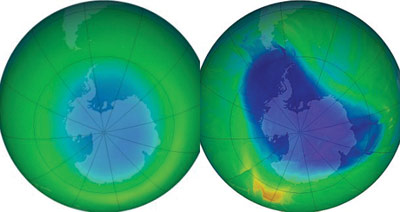|
 The ozone layer over Antarctica in September 1980, left, and how it looked this weekend. The dark blue indicates extremely low levels of ozone. Scientists expect it to return to pre-1980 levels by 2073. |
|
Ozone layer 'is no longer disappearing and will return to full strength by 2048', says UN report. The ozone layer is no longer disappearing and could be back to full strength by the middle of this century, UN scientists have confirmed. The phasing out of nearly 100 substances once used in products like refrigerators and aerosols has stopped the ozone layer being depleted further, although it is not yet increasing, according to a new United Nations report released last week. And it claimed that international efforts to protect the ozone layer has averted millions of cases of skin cancer worldwide. The ozone layer outside the polar regions is projected to recover to pre-1980 levels by 2048, although the annual springtime ozone hole over the Antarctic is not expected to recover until 2073. Ozone in the stratosphere is important because it absorbs some of the Sun’s dangerous ultraviolet radiation. The report, published jointly by UNEP and the UN World Meteorological Organization (WMO) is the first comprehensive update in four years on the Vienna Convention for the Protection of the Ozone Layer and the Montreal Protocol phasing out chemicals which accelerate both ozone layer damage and climate change. 'It (the Protocol) has protected the stratospheric ozone layer from much higher levels of depletion by phasing out production and consumption of ozone depleting substances,' said the report. The report was written and reviewed by 300 scientists and launched on the UN International Day for the Preservation of the Ozone Layer. Given that many substances that deplete the ozone layer are also potent greenhouse gases, the Montreal Protocol ‘provided substantial co-benefits by reducing climate change,’ it added. In 2010, reductions of ozone-depleting substances as a result of the Protocol, were five times larger than those targeted by the Kyoto Protocol, the greenhouse emissions reduction treaty. 'Without the Montreal Protocol and its associated Vienna Convention atmospheric levels of ozone-depleting substances could have increased tenfold by 2050,' Mr Steiner said. 'This in turn could have led to up to 20 million more cases of skin cancer and 130 million more cases of eye cataracts, not to speak of damage to human immune systems, wildlife and agriculture.' (Read by Renee Haines. Renee Haines is a journalist at the China Daily Web site.) (Agencies) |
聯(lián)合國報告稱,臭氧層“沒有繼續(xù)消失,并且會在2048年前完全恢復(fù)原狀”。 聯(lián)合國的科學(xué)家們已證實,臭氧層將不再消失,而且可能在本世紀(jì)中葉時恢復(fù)原狀。 根據(jù)聯(lián)合國上周發(fā)布的一份最新報告,隨著冰箱、噴霧器等產(chǎn)品曾使用的近100種物質(zhì)逐步被淘汰,臭氧層的進(jìn)一步耗竭已經(jīng)得到控制,盡管它還沒有開始增加。 該報告稱,保護(hù)臭氧層的全球行動已經(jīng)在世界范圍內(nèi)防止了數(shù)以百萬計的皮膚癌病例發(fā)生。 盡管每年春季出現(xiàn)在南極洲上空的臭氧空洞預(yù)計要到2073年才能恢復(fù),但是極地以外地區(qū)的臭氧層預(yù)計到2048年就可以恢復(fù)到1980年以前的水平。 平流層的臭氧非常重要,因為它可以吸收一部分有害的太陽紫外線輻射。 該報告由聯(lián)合國環(huán)境規(guī)劃署和聯(lián)合國世界氣象組織聯(lián)合發(fā)布,是四年來首次對《保護(hù)臭氧層維也納公約》和《蒙特利爾議定書》的全面更新。這兩份協(xié)定逐步廢止了加速臭氧層破壞和氣候變化的各種化學(xué)物質(zhì)。 報告稱,“通過逐步廢止臭氧消耗物質(zhì)的生產(chǎn)和消費,它(《議定書》)保護(hù)了平流層臭氧層,使其免于更大程度的耗竭。” 該報告由300位科學(xué)家撰寫和審閱,并于聯(lián)合國的國際臭氧層保護(hù)日發(fā)布。 報告還指出,鑒于許多損耗臭氧層的物質(zhì)也是很強(qiáng)的溫室氣體,《蒙特利爾議定書》“通過減緩氣候變化帶來了實質(zhì)性的衍生利益”。 2010年,由于《議定書》的實施,臭氧消耗物質(zhì)的減少量,比削減溫室氣體排放量的協(xié)議《京都議定書》規(guī)定的目標(biāo)削減量多出五倍。 (聯(lián)合國環(huán)境署總干事)斯特納先生說:“如果沒有《蒙特利爾議定書》及與之相關(guān)的《維也納公約》,大氣中臭氧消耗物質(zhì)的濃度到2050年將增加10倍。” “其相應(yīng)的后果是增加多達(dá)2000萬皮膚癌和1.3億白內(nèi)障病例,更不用說對人類免疫系統(tǒng)、野生動植物和農(nóng)業(yè)造成的危害了。” 相關(guān)閱讀 環(huán)保終見成效,南極臭氧空洞50年內(nèi)"填滿" (中國日報網(wǎng)英語點津 實習(xí)生強(qiáng)鳳華 編輯:陳丹妮) |
|
Vocabulary: phase out: discontinue a process, project, or service in phases(使)逐步淘汰 aerosol: a metal container in which a liquid such as paint or hairspray is kept under pressure and released as a spray(噴油漆、頭發(fā)定型劑等的)噴霧器,霧化器;氣霧劑;氣溶膠 deplete: to reduce something by a large amount so that there is not enough left (大量減少;耗盡;使枯竭) be projected to: 預(yù)計 stratosphere: the layer of the earth's atmosphere between about 10 and 50 kilometres above the surface of the earth(平流層;同溫層) potent: powerful(強(qiáng)大的;強(qiáng)有力的) eye cataract: 白內(nèi)障 |
